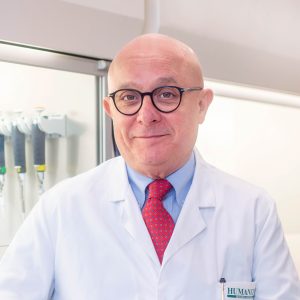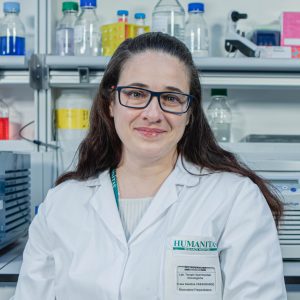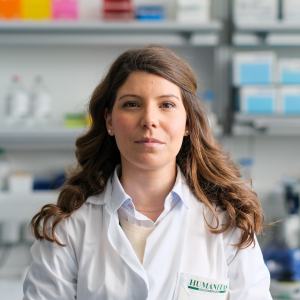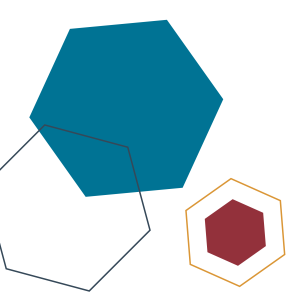Research Group
Carlo-Stella Group
Oncology Experimental Therapies Lab
Through a bedside-to-bench-and-back approach, our translational lab, tightly integrated with the clinical activity of the Lymphoid Malignancies and Cancer Therapeutics Unit of the hospital, investigates the cellular mechanisms involved in relapsed and refractory lymphoma with the aim of better predicting disease evolution and improving treatments response.
Main research areas
Signatures of response to immunotherapy in Diffuse Large B-cell Lymphoma
Novel immunotherapies, including chimeric antigen receptor (CAR) T-cell and bispecific antibodies, became available over the past five years for relapsed and refractory Diffuse Large B-Cell Lymphoma. On average, 50% of patients with relapsed and refractory Diffuse Large B-Cell Lymphoma fail to respond to these novel forms of immunotherapies, thus representing an unmet medical need. To address these issues, we started a translational project based on a personalized multi-omics approach to identify biomarkers for disease response and resistance mechanisms to immunotherapy.
Liquid biopsy for disease outcome prediction and monitoring by circulating tumor DNA
Approaches for staging and response evaluation in Diffuse Large B-Cell Lymphoma (DLBCL) and Hodgkin Lymphoma (cHL) rely upon serial imaging assessments, using positron emission tomography (PET) and computed tomography (CT) scans. However, conventional imaging has suboptimal positive and negative predictive values. The use of cell-free fragments of tumor DNA that are shed into the bloodstream from tumor cells and can be easily and repeatedly obtained is emerging as an easy-to-obtain material assessing somatic cancer mutations. We hypothesize that high-throughput sequencing of circulating tumor (ct)DNA to analyze mutational heterogeneity, as well as genomic evolution (mutNGS), may represent an attractive tool to predict disease outcome, monitor disease response and minimal residual disease, identify molecular determinants of chemorefractory patients and track clonal evolution-driven resistance to checkpoint inhibitors.
Selected publications
MicroRNA-127-3p controls murine hematopoietic stem cell maintenance by limiting differentiation.
The new refined minnesota risk score for acute graft-versus-host disease predicts overall survival and non-relapse mortality after T cell-replete haploidentical stem cell transplant with post-transplant cyclophosphamide.
Consensus report: clinical recommendations for the prevention and management of the nocebo effect in biosimilar-treated IBD patients.
Caspofungin for primary antifungal prophylaxis after T-cell-replete haploidentical stem cell transplantation with post-transplant cyclophosphamide.
Targeting Cancer Cells and Tumor Microenvironment in Preclinical and Clinical Models of Hodgkin Lymphoma Using the Dual PI3Kδ/γ Inhibitor RP6530.
Vascular amounts and dispersion of caliber-classified vessels as key parameters to quantitate 3D micro-angioarchitectures in multiple myeloma experimental tumors.
A reduced dose of fluconazole as primary antifungal prophylaxis is not associated with increased risk of invasive fungal infections after allogeneic stem cell transplantation from a HLA identical sibling.
Are EBV-related and EBV-unrelated Hodgkin lymphomas different with regard to susceptibility to checkpoint blockade?
Circulating tumor DNA reveals genetics, clonal evolution, and residual disease in classical Hodgkin lymphoma.
T Cell-Replete Haploidentical Transplantation with Post-Transplantation Cyclophosphamide for Hodgkin Lymphoma Relapsed after Autologous Transplantation: Reduced Incidence of Relapse and of Chronic Graft-versus-Host Disease Compared with HLA-Identical Related Donors.
Tandem autologous-haploidentical transplantation is a feasible and effective program for refractory Hodgkin lymphoma.
Genomic Integration of HHV-6 Mimicking Viral Reactivation after Autologous Stem Cell Transplantation.
Italian real-life experience with brentuximab vedotin: results of a large observational study of 40 cases of relapsed/refractory systemic anaplastic large cell lymphoma.
Tumour-derived PGD2 and NKp30-B7H6 engagement drives an immunosuppressive ILC2-MDSC axis.
Haploidentical transplantation with post-infusion cyclophosphamide in advanced Hodgkin lymphoma.
Safety and efficacy of allogeneic hematopoietic stem cell transplant after PD-1 blockade in relapsed/refractory lymphoma.
Estrogen receptor β ligation inhibits Hodgkin lymphoma growth by inducing autophagy.
The novel PI3K-δ inhibitor TGR-1202 enhances Brentuximab Vedotin-induced Hodgkin lymphoma cell death via mitotic arrest.
Outcomes of Hodgkin lymphoma patients who relapse after allogeneic stem cell transplantation.
Dual PI3K/ERK inhibition induces necroptotic cell death of Hodgkin Lymphoma cells through IER3 downregulation.
Bendamustine in Combination With Gemcitabine and Vinorelbine Is an Effective Regimen As Induction Chemotherapy Before Autologous Stem-Cell Transplantation for Relapsed or Refractory Hodgkin Lymphoma: Final Results of a Multicenter Phase II Study.
The patient’s CMV serological status affects clinical outcome after T-cell replete haplo-HSCT and post-transplant cyclophosphamide.
Desensitization with plasma exchange in a patient with human leukocyte antigen donor-specific antibodies before T-cell-replete haploidentical transplantation.
Tacrolimus compared with cyclosporine A after haploidentical T-cell replete transplantation with post-infusion cyclophosphamide.
T-replete haploidentical allogeneic transplantation using post-transplantation cyclophosphamide in advanced AML and myelodysplastic syndromes.
Tandem autologous-allogeneic stem cell transplantation as a feasible and effective procedure in high-risk lymphoma patients.
Primary refractory and early-relapsed Hodgkin’s lymphoma: strategies for therapeutic targeting based on the tumour microenvironment.
Role of naive-derived T memory stem cells in T-cell reconstitution following allogeneic transplantation.
High-dose melphalan with autologous stem cell support in refractory Hodgkin lymphoma patients as a bridge to second transplant.
Infections after T-replete haploidentical transplantation and high-dose cyclophosphamide as graft-versus-host disease prophylaxis.
Current role of autologous and allogeneic stem cell transplantation for relapsed and refractory hodgkin lymphoma.
Flow sorting and exome sequencing reveal the oncogenome of primary Hodgkin and Reed-Sternberg cells.
B-cell reconstitution recapitulates B-cell lymphopoiesis following haploidentical BM transplantation and post-transplant CY.
YM155 sensitizes triple-negative breast cancer to membrane-bound TRAIL through p38 MAPK- and CHOP-mediated DR5 upregulation.
High-dose sequential chemotherapy (HDS) versus PEB chemotherapy as first-line treatment of patients with poor prognosis germ-cell tumors: mature results of an Italian randomized phase II study.
Microenvironment-related biomarkers and novel targets in classical Hodgkin’s lymphoma.
Nonmyeloablative conditioning, unmanipulated haploidentical SCT and post-infusion CY for advanced lymphomas.
Phase II study of perifosine and sorafenib dual-targeted therapy in patients with relapsed or refractory lymphoproliferative diseases.
Synergistic anti-tumor activity and inhibition of angiogenesis by cotargeting of oncogenic and death receptor pathways in human melanoma.
BIM upregulation and ROS-dependent necroptosis mediate the antitumor effects of the HDACi Givinostat and Sorafenib in Hodgkin lymphoma cell line xenografts.
Predictors of CD34+ cell mobilization and collection in adult men with germ cell tumors: implications for the salvage treatment strategy.
Role of alpha-synuclein in autophagy modulation of primary human T lymphocytes.
Bone marrow compared with peripheral blood stem cells for haploidentical transplantation with a nonmyeloablative conditioning regimen and post-transplantation cyclophosphamide.
Results of a randomized trial comparing high-dose chemotherapy plus Auto-SCT and R-FC in CLL at diagnosis.
Plerixafor ‘on demand’: results of a strategy based on peripheral blood CD34+ cells in lymphoma patients at first or subsequent mobilization with chemotherapy+G-CSF.
Peripheral blood CD34+ cell monitoring after cyclophosphamide and granulocyte-colony-stimulating factor: an algorithm for the pre-emptive use of plerixafor.
Autophagy as a pathogenic mechanism and drug target in lymphoproliferative disorders.
The role of inflammation in lymphoma.
Constitutive localization of DR4 in lipid rafts is mandatory for TRAIL-induced apoptosis in B-cell hematologic malignancies.
Long-Term Results of Autologous Hematopoietic Stem-Cell Transplantation After High-Dose 90Y-Ibritumomab Tiuxetan for Patients With Poor-Risk Non-Hodgkin Lymphoma Not Eligible for High-Dose BEAM.
Perifosine and sorafenib combination induces mitochondrial cell death and antitumor effects in NOD/SCID mice with Hodgkin lymphoma cell line xenografts.
Induction of death receptor 5 expression in tumor vasculature by perifosine restores the vascular disruption activity of TRAIL-expressing CD34(+) cells.
Sorafenib inhibits lymphoma xenografts by targeting MAPK/ERK and AKT pathways in tumor and vascular cells.
(3)D [corrected] quantification of tumor vasculature in lymphoma xenografts in NOD/SCID mice allows to detect differences among vascular-targeted therapies.
The strange case of the lost NRAS mutation in a child with juvenile myelomonocytic leukemia.
Phase II study of sorafenib in patients with relapsed or refractory lymphoma.
Telomere loss in Philadelphia-negative hematopoiesis after successful treatment of chronic myeloid leukemia: evidence for premature aging of the myeloid compartment.
Role of Apollon in human melanoma resistance to antitumor agents that activate the intrinsic or the extrinsic apoptosis pathways.
Detection of minimal residual disease in hematopoietic progenitor cell harvests: lack of predictive value of peripheral blood and bone marrow analysis in mantle cell and indolent lymphoma.
Novel second mitochondria-derived activator of caspases (Smac) mimetic compounds sensitize human leukemic cell lines to conventional chemotherapeutic drug-induced and death receptor-mediated apoptosis.
Myeloablative doses of yttrium-90-ibritumomab tiuxetan and the risk of secondary myelodysplasia/acute myelogenous leukemia.
Serological identification of HSP105 as a novel non-Hodgkin lymphoma therapeutic target.
Improved clinical outcome in indolent B-cell lymphoma patients vaccinated with autologous tumor cells experiencing immunogenic death.
Long-term results of high-dose chemotherapy with autologous bone marrow or peripheral stem cell transplant as first salvage treatment for relapsed or refractory Hodgkin lymphoma: a single institution experience.
Efficacy and safety of high-dose chemotherapy with in vivo purged auto-SCT in relapsed follicular lymphoma: long-term follow-up.
Human CD34+ cells engineered to express membrane-bound tumor necrosis factor-related apoptosis-inducing ligand target both tumor cells and tumor vasculature.
Comparative assessment of telomere length before and after hematopoietic SCT: role of grafted cells in determining post-transplant telomere status.
Radioimmunotherapy and secondary leukemia: a case report.
Germ-line mutation of the NRAS gene may be responsible for the development of juvenile myelomonocytic leukaemia.
Absorbed dose and biologically effective dose in patients with high-risk non-Hodgkin’s lymphoma treated with high-activity myeloablative 90Y-ibritumomab tiuxetan (Zevalin).
A computational approach to compare microvessel distributions in tumors following antiangiogenic treatments.
Haploidentical stem cell transplantation after a reduced-intensity conditioning regimen for the treatment of advanced hematologic malignancies: posttransplantation CD8-depleted donor lymphocyte infusions contribute to improve T-cell recovery.
High-dose sequential chemotherapy and in vivo rituximab-purged stem cell autografting in mantle cell lymphoma: a 10-year update of the R-HDS regimen.
Vaccination with autologous tumor-loaded dendritic cells induces clinical and immunologic responses in indolent B-cell lymphoma patients with relapsed and measurable disease: a pilot study.
High-dose yttrium-90-ibritumomab tiuxetan with tandem stem-cell reinfusion: an outpatient preparative regimen for autologous hematopoietic cell transplantation.
The effect of artificial antigen-presenting cells with preclustered anti-CD28/-CD3/-LFA-1 monoclonal antibodies on the induction of ex vivo expansion of functional human antitumor T cells.
Anticancer cell therapy with TRAIL-armed CD34+ progenitor cells.
Highly efficient gene transfer into mobilized CD34+ hematopoietic cells using serotype-5 adenoviral vectors and BoosterExpress Reagent.
Targeting TRAIL agonistic receptors for cancer therapy.
Long-term lymphoma survivors following high-dose chemotherapy and autograft: evidence of permanent telomere shortening in myeloid cells, associated with marked reduction of bone marrow hematopoietic stem cell reservoir.
Forced expression of RDH10 gene retards growth of HepG2 cells.
Placental growth factor-1 potentiates hematopoietic progenitor cell mobilization induced by granulocyte colony-stimulating factor in mice and nonhuman primates.
Antitumor activity of human CD34+ cells expressing membrane-bound tumor necrosis factor-related apoptosis-inducing ligand.
CD52 antigen expressed by malignant plasma cells can be targeted by alemtuzumab in vivo in NOD/SCID mice.
The anti-human leukocyte antigen-DR monoclonal antibody 1D09C3 activates the mitochondrial cell death pathway and exerts a potent antitumor activity in lymphoma-bearing nonobese diabetic/severe combined immunodeficient mice.
Topical prophylaxis of conjunctivitis induced by high-dose cytosine arabinoside.
Skewed T-cell differentiation in patients with indolent non-Hodgkin lymphoma reversed by ex vivo T-cell culture with gammac cytokines.
Genetic idiotypic and tumor cell-based vaccine strategies for indolent non Hodgkin’s lymphoma.
Reduced-intensity conditioning containing low-dose alemtuzumab before allogeneic peripheral blood stem cell transplantation: graft-versus-host disease is decreased but T-cell reconstitution is delayed.
Marked telomere shortening in mobilized peripheral blood progenitor cells (PBPC) following two tightly spaced high-dose chemotherapy courses with G-CSF.
High response rate and manageable toxicity with an intensive, short-term chemotherapy programme for Burkitt’s lymphoma in adults.
Boosting T cell-mediated immunity to tyrosinase by vaccinia virus-transduced, CD34(+)-derived dendritic cell vaccination: a phase I trial in metastatic melanoma.
Use of recombinant human growth hormone (rhGH) plus recombinant human granulocyte colony-stimulating factor (rhG-CSF) for the mobilization and collection of CD34+ cells in poor mobilizers.
Specific histone patterns and acetylase/deacetylase activity at the breakpoint-cluster region of the human MLL gene.
Age- and irradiation-associated loss of bone marrow hematopoietic function in mice is reversed by recombinant human growth hormone.
Mobilization of primitive and committed hematopoietic progenitors in nonhuman primates treated with defibrotide and recombinant human granulocyte colony-stimulating factor.
Dendritic cell viability is decreased after phagocytosis of apoptotic tumor cells induced by staurosporine or vaccinia virus infection.
Clinical protocol. Immunization of patients with malignant melanoma with autologous CD34(+) cell-derived dendritic cells transduced ex vivo with a recombinant replication-deficient vaccinia vector encoding the human tyrosinase gene: a phase I trial.
Downmodulation of ERK activity inhibits the proliferation and induces the apoptosis of primary acute myelogenous leukemia blasts.
Long-term remission in mantle cell lymphoma following high-dose sequential chemotherapy and in vivo rituximab-purged stem cell autografting (R-HDS regimen).
Identical rearrangement of immunoglobulin heavy chain gene in neoplastic Langerhans cells and B-lymphocytes: evidence for a common precursor.
Defibrotide in combination with granulocyte colony-stimulating factor significantly enhances the mobilization of primitive and committed peripheral blood progenitor cells in mice.
Human bone marrow stromal cells suppress T-lymphocyte proliferation induced by cellular or nonspecific mitogenic stimuli.
Bleomycin genotoxicity and amifostine (WR-2721) cell protection in normal leukocytes vs. K562 tumoral cells.
Limited engraftment capacity of bone marrow-derived mesenchymal cells following T-cell-depleted hematopoietic stem cell transplantation.
Large-scale feasibility of gene transduction into human CD34+ cell-derived dendritic cells by adenoviral/polycation complex.
Amifostine (WR-2721) selective protection against melphalan genotoxicity.
Transforming growth factor beta3 inhibits chronic myelogenous leukemia hematopoiesis by inducing Fas-independent apoptosis.
T-lymphocyte function after retroviral-mediated thymidine kinase gene transfer and G418 selection.
Therapeutic relevance of CD34 cell dose in blood cell transplantation for cancer therapy.
Peripheral blood progenitor cell mobilization in healthy donors receiving recombinant human granulocyte colony-stimulating factor.
Selective expression and constitutive phosphorylation of SHC proteins [corrected] in the CD34+ fraction of chronic myelogenous leukemias.
Cell therapy: achievements and perspectives.
Therapy of molecular relapse in acute promyelocytic leukemia.
Induction of apoptosis by arachidonic acid in chronic myeloid leukemia cells.
DNA damage by tobacco smoke and some antiblastic drugs evaluated using the Comet assay.
Recombinant adenoviral vector-lipofectAMINE complex for gene transduction into human T lymphocytes.
Effects of the tyrosine kinase inhibitor AG957 and an Anti-Fas receptor antibody on CD34(+) chronic myelogenous leukemia progenitor cells.
New reciprocal translocation t(5;10)(q33;q22) associated with atypical chronic myeloid leukemia.
Primitive hematopoietic progenitors within mobilized blood are spared by uncontrolled rate freezing.
Ex vivo expansion of hematopoietic cells and their clinical use.
The parallel between CD45 expression and extra-medullary evolution in aggressive myeloma with high serum lactate dehydrogenase.
CD34+ cells mobilized by cyclophosphamide and granulocyte colony-stimulating factor (G-CSF) are functionally different from CD34+ cells mobilized by G-CSF.
Reverse transcription polymerase chain reaction is a reliable assay for detecting leukemic colonies generated by chronic myelogenous leukemia cells.
Biologic and phenotypic analysis of early hematopoietic progenitor cells in umbilical cord blood.
Retroviral transfer of herpes simplex virus-thymidine kinase and beta-galactosidase genes into U937 cells with bicistronic vector.
Effect of chemotherapy for acute myelogenous leukemia on hematopoietic and fibroblast marrow progenitors.
Stem cell manipulation: why and how performing peripheral blood progenitor cell purging.
Clonogenic capacity and ex vivo expansion potential of umbilical cord blood progenitor cells are not impaired by cryopreservation.
Use of granulocyte-macrophage colony-stimulating factor (GM-CSF) in combination with hydroxyurea as post-transplant therapy in chronic myelogenous leukemia patients autografted with unmanipulated hematopoietic cells.
In vitro growth of mobilized peripheral blood progenitor cells is significantly enhanced by stem cell factor.
Arachidonic acid mediates interleukin-1 and tumor necrosis factor-alpha-induced activation of the c-jun amino-terminal kinases in stromal cells.
Stem cells and stem cell transplantation.
Selection of myeloid progenitors lacking BCR/ABL mRNA in chronic myelogenous leukemia patients after in vitro treatment with the tyrosine kinase inhibitor genistein.
Detection of maternal progenitor cells in human umbilical cord blood by single-colony karyotyping.
Effect of the protein tyrosine kinase inhibitor genistein on normal and leukaemic haemopoietic progenitor cells.
BCL2 oncogene protein expression in human hematopoietic precursors during fetal life.
Density separation and cryopreservation of umbilical cord blood cells: evaluation of recovery in short-and long-term cultures.
Oligodeoxynucleotides antisense to c-abl specifically inhibit entry into S-phase of CD34+ hematopoietic cells and their differentiation to granulocyte-macrophage progenitors.
Arachidonic acid induces c-jun gene expression in stromal cells stimulated by interleukin-1 and tumor necrosis factor-alpha: evidence for a tyrosine-kinase-dependent process.
Density separation of umbilical cord blood and recovery of hemopoietic progenitor cells: implications for cord blood banking.
Natural killer cell regeneration after transplantation with mafosfamide purged autologous bone marrow.
Stem cell purging: an intriguing dilemma.
Granulocyte colony-stimulating factor (G-CSF) prevents dose-limiting neutropenia in lymphoma patients receiving standard dose chemotherapy.
Autologous transplant for chronic myelogenous leukemia using marrow treated ex vivo with mafosfamide.
Identification of Philadelphia-negative granulocyte-macrophage colony-forming units generated by stroma-adherent cells from chronic myelogenous leukemia patients.
Acquired cyclic thrombocytopenia-thrombocytosis with periodic defect of platelet function.
Counterflow centrifugal elutriation: present and future.
Use of recombinant human granulocyte-macrophage colony-stimulating factor in patients with lymphoid malignancies transplanted with unpurged or adjusted-dose mafosfamide-purged autologous marrow.
Autologous bone marrow transplantation in acute myelogenous leukemia.
Differential sensitivity of adherent CFU-blast, CFU-mix, BFU-E, and CFU-GM to mafosfamide: implications for adjusted dose purging in autologous bone marrow transplantation.
In vitro marrow purging in chronic myelogenous leukemia: effect of mafosfamide and recombinant granulocyte–macrophage colony-stimulating factor.
Tumor necrosis factor alpha modulates the messenger RNA expression of hematopoietic growth factor genes in fresh blast cells from patients with acute myeloblastic leukemia.
Regulation of early hematopoiesis in serum-deprived cultures of mafosfamide-treated and untreated CD34-enriched bone marrow cells.
Establishment and characterization of a B-cell line derived from a patient with a myelodysplastic syndrome which expresses myelomonocytic and lymphoid markers.
Human peripheral blood mononuclear cell subfractionation using counterflow centrifugation elutriation.
Growth of CD34+ acute myeloblastic leukemia colony-forming cells in response to recombinant hematopoietic growth factors.
Tumor necrosis factor alpha down-regulates c-myc mRNA expression and induces in vitro monocytic differentiation in fresh blast cells from patients with acute myeloblastic leukemia.
In vitro and in vivo effects of recombinant interferon gamma on the growth of hematopoietic progenitor cells from patients with myelodysplastic syndrome.
Growth of human hematopoietic colonies from patients with myelodysplastic syndromes in response to recombinant human granulocyte-macrophage colony-stimulating factor.
In vitro growth of bone marrow-derived multipotent and lineage-restricted hematopoietic progenitor cells in myelodysplastic syndromes.
Effects of desferrioxamine on normal and leukemic human hematopoietic cell growth: in vitro and in vivo studies.
Establishment of two Epstein-Barr virus negative Burkitt cell lines from a patient with AIDS and B-cell lymphoma.
Synergistic antiproliferative effect of recombinant interferon-gamma with recombinant interferon-alpha on chronic myelogenous leukemia hematopoietic progenitor cells (CFU-GEMM, CFU-Mk, BFU-E, and CFU-GM).
Effect of recombinant gamma interferon on the proliferative activity of cultured leukemic cells.
Effects of recombinant human H-subunit and L-subunit ferritins on in vitro growth of human granulocyte-monocyte progenitors.
Recombinant gamma-interferon induces in vitro monocytic differentiation of blast cells from patients with acute nonlymphocytic leukemia and myelodysplastic syndromes.
“In vitro” megakaryocytopoiesis in patients with HIV-related thrombocytopenic purpura.
Effects of recombinant alpha and gamma interferons on the in vitro growth of circulating hematopoietic progenitor cells (CFU-GEMM, CFU-Mk, BFU-E, and CFU-GM) from patients with myelofibrosis with myeloid metaplasia.
Effect of recombinant interferons alpha and gamma on human bone marrow-derived megakaryocytic progenitor cells.
Defective in vitro growth of the hemopoietic progenitor cells in the acquired immunodeficiency syndrome.
Clinical relevance of two in vitro tests based on CFU-GM assay in the study of granulopoietic failure.
Cell- and humoral-mediated granulopoietic failure detected by CFU-GM assay in one case of Felty’s syndrome unresponsive to prednisolone treatment.
Significance of marrow-blood barrier for CFU-GM in patients with acute nonlymphoid leukemia (AnLL).
Circulating granulocytic progenitor cell (CFU-GM) cultures in a long surviving case of smouldering leukemia.
Spectrum of bone marrow cluster- and colony-forming units in healthy adult subjects.
Myelodysplastic syndrome with monosomy 7 in adulthood: a distinct preleukaemic disorder.
“Overshoot” phenomenon in circulating granulocytic progenitor cell growth during remission of blast crisis in a case of CML.
Expression and activation of SHC/MAP kinase pathway in primary acute myeloid leukemia blasts
Group members





